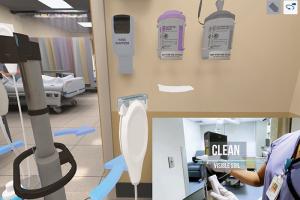Measuring hospital energy performance
Is one of the hospitals in your health system using significantly more energy than the rest? Is your entire building portfolio performing below the national average for health systems in energy use intensity (EUI)? Have you experienced an unexplained surge in energy costs not attributable to utility rate increases?
The only way to find out is to benchmark energy performance: Measure energy consumption in each hospital and outpatient facility and compare these measurements with one another and against external averages or standards.
“If you don’t get benchmarked, you can’t measure what you’re doing,” says Terry M. Scott, SASHE, CHFM, CHSP, president-elect of the American Society for Healthcare Engineering (ASHE).
Unnecessary energy use
In hospitals and other types of commercial buildings, as much as 30 percent of the energy consumed is used unnecessarily, says Clark A. Reed, national program manager for Energy Star Commercial Buildings, a division of the Environmental Protection Agency (EPA).
“Energy is about 50 percent of a health care facility manager’s budget,” Scott says. Thus, by measuring and then reducing their energy consumption, hospitals and health systems of all sizes can significantly lower their operating costs.

For example, Houston-based Memorial Hermann Health System, which has 14 hospitals in southeastern Texas, saved $47 million in five years by implementing energy-saving measures, says Scott, who serves as the director of engineering and construction services for three of the hospitals.
Besides saving money, energy-conservation practices have the potential to improve patient health and satisfaction. Upgrading heating, ventilation and air conditioning systems, for instance, may enhance indoor air quality and reduce airborne infection, while use of natural light where possible can elevate the mood of patients and decrease their anxiety and stress.
On a per-building basis, hospitals use an average of 600,000 million British thermal units of energy per year, far exceeding any other building type, according to the Department of Energy’s “Advanced Energy Retrofit Guide — Healthcare Facilities,” which was published in September 2013. Health systems can build goodwill in the communities they serve by embracing such environmentally responsible policies as energy reduction.
As a first step in energy conservation, benchmarking establishes an initial performance baseline. Then, as problems and inefficiencies are pinpointed and corrected, ongoing benchmarking tracks improvements over time.
Gauging energy efficiency
Health care facility managers can use a number of online resources to begin benchmarking. Several facilities use the EPA’s free benchmarking tool, Energy Star Portfolio Manager, allowing users to track energy use and compare their EUI measurements with national averages.
The program requires entering data from utility bills and various operational characteristics, such as gross floor area; number of staffed beds and full-time equivalent workers; the number of magnetic resonance imaging machines; and the presence or absence of tertiary care.
“General medical or surgical hospitals will get a baseline score, from which they can set goals and see how they compare with similar facilities across the country,” Reed says.
The 4,939 hospitals benchmarking in Portfolio Manager range in EUI from less than 100 kilo Btu (kBtu) per sq. ft. to more than 1,400 kBtu per sq. ft., with a median of 467 kBtu per sq. ft. Although hospitals with lower EUI typically receive higher Energy Star scores on a scale of 1 to 100, the scoring system normalizes for the effects of size, operational intensity and climate. The way to earn an above-average score is to use less energy than would be expected of a facility with those characteristics in that region of the country.
After entering a year’s worth of utility data, facilities that consistently perform in the top 25th percentile for energy performance — those receiving a score of at least 75 out of 100 — can apply for Energy Star certification. The data must be independently verified by a professional engineer or architect.
“It took us about four years to achieve Energy Star certification,” says Scott, who notes that eight of Memorial Hermann’s hospitals now have this designation. “Meeting every other Friday at the time, our energy committee did nothing but find ways to reduce energy consumption.”
ASHE has integrated Portfolio Manager into its own benchmarking and energy-reduction initiative, Energy to Care. This program offers additional features, including an energy-monitoring dashboard designed specifically for health facilities, user assistance and support, and the opportunity to share data and compete in challenges with other Energy to Care participants. Facilities that reduce energy consumption by 10 percent in the first year and 5 percent in the second year receive awards from ASHE.
Competing for savings
Facility managers sometimes are reluctant to start benchmarking because they fear being judged for poor energy performance or they think the process will increase their workload, Scott explains.
Indeed, when hospitals benchmark energy usage for the first time, the data entry can be onerous, he says, but it can be done in a couple of days if all the needed information is gathered ahead of time. For ongoing benchmarking, proprietary software programs are available that save time by automatically uploading utility data into Portfolio Manager.
Scott points out that to get the buy-in of facility managers, it’s important to make the process fun by having friendly competitions — either internally among hospitals in a health system or externally against other hospitals in a municipality, state or region. The key is to recognize winners but not shame losers.
For example, the Texas ASHE chapter sponsored an energy-reduction competition called the Texas Energy Roundup. “Of the 75 health care facilities that were benchmarked in 2013, $13.7 million was saved,” Scott says. ASHE presented awards to the winning hospitals at its 2014 annual conference. The challenge was held again in 2014 with 100 hospital participants. This year, the Ohio ASHE chapter has challenged the Texas chapter to a competition.
Benchmarking is a decision-making process that involves more than measuring and comparing energy-usage data. Health system leaders must set strategic performance goals. Are you simply looking for your facilities to improve from their initial performance baseline? Or do you want them to reach a best-in-class bar set by your top performers? Do you eventually expect all of your facilities to attain Energy Star certification?
Energy benchmarking must be continuous, Scott insists.
“We benchmark every month,” he says. “Last month, one of our hospitals was up by 10 percent. That tells us that something is going on somewhere. Maybe there is a steam leak. Or maybe something that was being shut off in an office building isn’t being shut off anymore. When you have the data, you can investigate.
“If you stop benchmarking, things go back to the way they were before. You have to start and keep benchmarking to be successful."
For more information
To learn more about benchmarking hospital energy usage, access these resources, which were referenced in the article:



